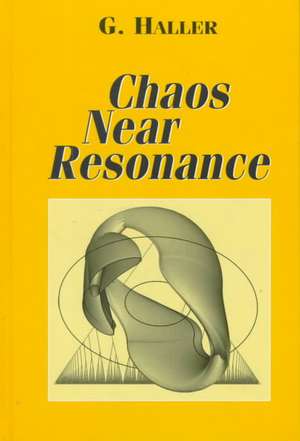Chaos Near Resonance: Applied Mathematical Sciences, cartea 138
Autor G. Halleren Limba Engleză Hardback – 24 sep 1999
| Toate formatele și edițiile | Preț | Express |
|---|---|---|
| Paperback (1) | 397.01 lei 6-8 săpt. | |
| Springer – 17 oct 2012 | 397.01 lei 6-8 săpt. | |
| Hardback (1) | 401.24 lei 6-8 săpt. | |
| Springer – 24 sep 1999 | 401.24 lei 6-8 săpt. |
Din seria Applied Mathematical Sciences
- 13%
 Preț: 426.94 lei
Preț: 426.94 lei - 13%
 Preț: 426.46 lei
Preț: 426.46 lei - 13%
 Preț: 427.63 lei
Preț: 427.63 lei - 24%
 Preț: 906.78 lei
Preț: 906.78 lei - 23%
 Preț: 659.05 lei
Preț: 659.05 lei -
 Preț: 375.64 lei
Preț: 375.64 lei - 18%
 Preț: 909.47 lei
Preț: 909.47 lei - 18%
 Preț: 795.02 lei
Preț: 795.02 lei - 18%
 Preț: 950.52 lei
Preț: 950.52 lei - 15%
 Preț: 645.47 lei
Preț: 645.47 lei - 20%
 Preț: 755.46 lei
Preț: 755.46 lei -
 Preț: 382.65 lei
Preț: 382.65 lei - 24%
 Preț: 808.03 lei
Preț: 808.03 lei -
 Preț: 452.62 lei
Preț: 452.62 lei -
 Preț: 190.23 lei
Preț: 190.23 lei -
 Preț: 399.12 lei
Preț: 399.12 lei - 18%
 Preț: 966.90 lei
Preț: 966.90 lei - 15%
 Preț: 643.48 lei
Preț: 643.48 lei - 15%
 Preț: 528.80 lei
Preț: 528.80 lei -
 Preț: 413.15 lei
Preț: 413.15 lei -
 Preț: 390.25 lei
Preț: 390.25 lei - 18%
 Preț: 736.01 lei
Preț: 736.01 lei - 18%
 Preț: 1411.05 lei
Preț: 1411.05 lei - 15%
 Preț: 711.21 lei
Preț: 711.21 lei -
 Preț: 395.47 lei
Preț: 395.47 lei - 18%
 Preț: 1017.26 lei
Preț: 1017.26 lei -
 Preț: 403.15 lei
Preț: 403.15 lei - 18%
 Preț: 1130.14 lei
Preț: 1130.14 lei - 18%
 Preț: 1134.87 lei
Preț: 1134.87 lei - 18%
 Preț: 1329.00 lei
Preț: 1329.00 lei - 18%
 Preț: 1129.65 lei
Preț: 1129.65 lei - 18%
 Preț: 1140.71 lei
Preț: 1140.71 lei - 15%
 Preț: 653.14 lei
Preț: 653.14 lei
Preț: 401.24 lei
Nou
Puncte Express: 602
Preț estimativ în valută:
76.78€ • 80.00$ • 63.57£
76.78€ • 80.00$ • 63.57£
Carte tipărită la comandă
Livrare economică 03-17 aprilie
Preluare comenzi: 021 569.72.76
Specificații
ISBN-13: 9780387986975
ISBN-10: 0387986979
Pagini: 430
Ilustrații: XVI, 430 p.
Dimensiuni: 155 x 235 x 28 mm
Greutate: 0.73 kg
Ediția:1999
Editura: Springer
Colecția Springer
Seria Applied Mathematical Sciences
Locul publicării:New York, NY, United States
ISBN-10: 0387986979
Pagini: 430
Ilustrații: XVI, 430 p.
Dimensiuni: 155 x 235 x 28 mm
Greutate: 0.73 kg
Ediția:1999
Editura: Springer
Colecția Springer
Seria Applied Mathematical Sciences
Locul publicării:New York, NY, United States
Public țintă
ResearchCuprins
1 Concepts From Dynamical Systems.- 1.1 Flows, Maps, and Dynamical Systems.- 1.2 Ordinary Differential Equations as Dynamical Systems.- 1.3 Liouville’s Theorem.- 1.4 Structural Stability and Bifurcation.- 1.5 Hamiltonian Systems.- 1.6 Poincaré—Cartan Integral Invariant.- 1.7 Generating Functions.- 1.8 Infinite-Dimensional Hamiltonian Systems.- 1.9 Symplectic Reduction.- 1.10 Integrable Systems.- 1.11 KAM Theory and Whiskered Tori.- 1.12 Invariant Manifolds.- 1.13 Stable and Unstable Manifolds.- 1.14 Stable and Unstable Foliations.- 1.15 Strong Stable and Unstable Manifolds.- 1.16 Weak Hyperbolicity.- 1.17 Homoclinic Orbits and Homoclinic Manifolds.- 1.18 Singular Perturbations and Slow Manifolds.- 1.19 Exchange Lemma.- 1.20 Exchange Lemma and Observability.- 1.21 Normal Forms.- 1.22 Averaging Methods.- 1.23 Lambda Lemma and the Homoclinic Tangle.- 1.24 Smale Horseshoes and Symbolic Dynamics.- 1.25 Chaos.- 1.26 Hyperbolic Sets, Transient Chaos, and Strange Attractors.- 1.27 Melnikov Methods.- 1.28 Šilnikov Orbits.- 2 Chaotic Jumping Near Resonances: Finite-Dimensional Systems.- 2.1 Resonances and Slow Manifolds.- 2.2 Assumptions and Definitions.- 2.3 Passage Lemmas.- 2.4 Tracking Lemmas.- 2.5 Energy Lemmas.- 2.6 Existence of Multipulse Orbits.- 2.7 Disintegration of Invariant Manifolds Through Jumping.- 2.8 Dissipative Chaos: Generalized Šilnikov Orbits.- 2.9 Hamiltonian Chaos: Homoclinic Tangles.- 2.10 Universal Homoclinic Bifurcations in Hamiltonian Applications.- 2.11 Heteroclinic Jumping Between Slow Manifolds.- 2.12 Partially Slow Manifolds of Higher Codimension.- 2.13 Bibliographical Notes.- 3 Chaos Due to Resonances in Physical Systems.- 3.1 Oscillations of a Parametrically Forced Beam.- 3.2 Resonant Surface-Wave Interactions.- 3.3 Chaotic Pitching ofNonlinear Vibration Absorbers.- 3.4 Mechanical Systems With Widely Spaced Frequencies.- 3.5 Irregular Particle Motion in the Atmosphere.- 3.6 Subharmonic Generation in an Optical Cavity.- 3.7 Intermittent Bursting in Turbulent Boundary Layers.- 3.8 Further Problems.- 4 Resonances in Hamiltonian Systems.- 4.1 Resonant Equilibria.- 4.2 The Classical Water Molecule.- 4.3 Dynamics Near Intersecting Resonances.- 4.4 An Example From Rigid Body Dynamics.- 4.5 Resonances in A Priori Unstable Systems.- 5 Chaotic Jumping Near Resonances: Infinite-Dimensional Systems.- 5.1 The Main Examples.- 5.2 Assumptions and Definitions.- 5.3 Invariant Manifolds and Foliations.- 5.4 Passage Lemmas.- 5.5 Tracking Lemmas.- 5.6 Energy Lemmas.- 5.7 Multipulse Homoclinic Orbits in Sobolev Spaces.- 5.8 Disintegration of Invariant Manifolds Through Jumping.- 5.9 Generalized Šilnikov Orbits.- 5.10 The Purely Hamiltonian Case.- 5.11 Homoclinic Jumping in the Perturbed NLS Equation.- 5.12 Partially Slow Manifolds of Higher Codimension.- 5.13 Homoclinic Jumping in the CNLS System.- 5.14 Bibliographical Notes.- A Elements of Differential Geometry.- A.1 Manifolds.- A.2 Tangent, Cotangent, and Normal Bundles.- A.3 Transversality.- A.4 Maps on Manifolds.- A.5 Regular and Critical Points.- A.6 Lie Derivative.- A.7 Lie Algebras, Lie Groups, and Their Actions.- A.8 Orbit Spaces.- A.9 Infinite-Dimensional Manifolds.- A.10 Differential Forms.- A.11 Maps and Differential Forms.- A.12 Exterior Derivative.- A.13 Closed and Exact Forms.- A.14 Lie Derivative of Forms.- A.15 Volume Forms and Orientation.- A.16 Symplectic Forms.- A.17 Poisson Brackets.- A.18 Integration on Manifolds and Stokes’s Theorem.- B Some Facts From Analysis.- B.1 Fourier Series.- B.2 Gronwall Inequality.- B.3 Banach and Hilbert Spaces.- B.4Differentiation and the Mean Value Theorem.- B.5 Distributions and Generalized Derivatives.- B.6 Sobolev Spaces.- B.8 Factorization of Functions With a Zero.- References.- Symbol Index.
Recenzii
"An extensive bibliography and the many examples make this clearly-written book an excellent introduction to these techniques for identifying chaos in perturbations of systems with resonance."
Applied Mechanics Reviews, Vol. 53/4, April 2000
"Haller makes a point of wanting to see dynamical systems theory fulfil "its long-standing promise to solve real-life problems". His book, through a wealth of detailed examples, delivers on this promise, and is certain ti become a standard text in this area. In particular, it is an excellent introduction to this research area, and contains a wealth of bibliographical and historical detail.
Matthew Nicol, Bulletin of the LMS, No. 162, Vol. 33/3, May 2001
Applied Mechanics Reviews, Vol. 53/4, April 2000
"Haller makes a point of wanting to see dynamical systems theory fulfil "its long-standing promise to solve real-life problems". His book, through a wealth of detailed examples, delivers on this promise, and is certain ti become a standard text in this area. In particular, it is an excellent introduction to this research area, and contains a wealth of bibliographical and historical detail.
Matthew Nicol, Bulletin of the LMS, No. 162, Vol. 33/3, May 2001














